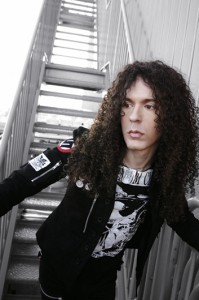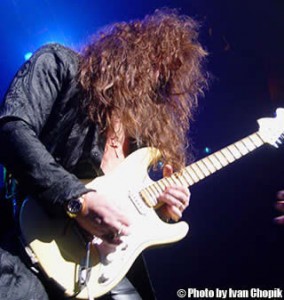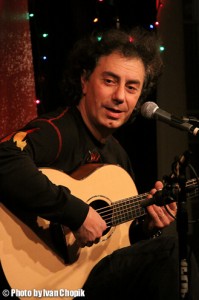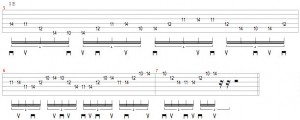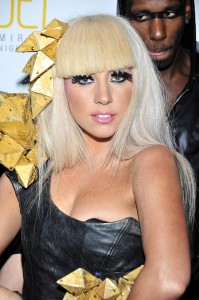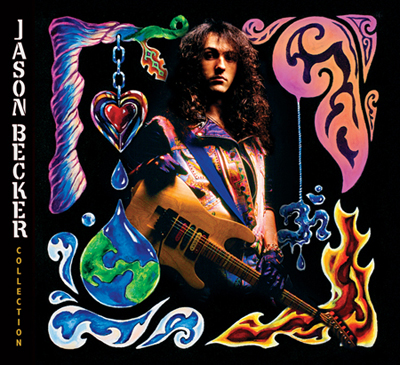 Jason Becker was born on July 22, 1969 and started playing the guitar at the age of 5. By the time Jason was only 16 he was already being praised as a guitar virtuoso and was one of the hottest up and coming players on the rock and metal scene. It was around this time that he joined forces with Marty Friedman to form Cacophony, a band which has provided us with some of the most mind-boggling metal compositions and performances to date.
Jason Becker was born on July 22, 1969 and started playing the guitar at the age of 5. By the time Jason was only 16 he was already being praised as a guitar virtuoso and was one of the hottest up and coming players on the rock and metal scene. It was around this time that he joined forces with Marty Friedman to form Cacophony, a band which has provided us with some of the most mind-boggling metal compositions and performances to date.
At 20 Jason joined David Lee Roth’s band and shortly thereafter was diagnosed with ALS (Lou Gehrig’s Disease). In 1992 he was set up with a computer and music software so he could continue composing with his one good hand. Jason managed to finish writing his album, Perspective, but after that he could no longer move or speak. He now communicates with eye movements using a system invented by his father.
Despite the immense hardships that Jason has had to face throughout his life, he has been an inspiration to countless people by maintaining his positive spirit and attitude throughout the years. Today Jason remains an active composer and in late 2008 released Collection – an album consisting of some of his most outstanding material from previous releases, as well as several brand new tracks, which feature guest performances by a number of prominent musicians, including Joe Satriani, Michael Lee Firkins, Greg Howe, and Steve Vai.
IC: How are you? How are you feeling these days? Last we heard you had been feeling better with increased strength in several muscles.
JB: I am feeling fantabulous. Since I had written about getting more muscle strength, I haven’t improved physically, but I haven’t gotten worse, which is pretty awesome for this disease. I am totally cool both physically and mentally at this point. I have heard rumors of my death and rumors of my healing. I’ve tried death. It’s got its good and bad points. I might try healing sometime.
IC: The Jason Becker Collection album and Signature Guitar have just recently been released, but you’re involved in a number of other projects as well – an autobiography, documentary, and signature distortion pedal. What is the status on these projects and do you have any other upcoming plans?
JB: Finishing my autobiography is my next goal. I really need to get that out there so people in my position can read about another way of looking at life. I often read about people with ALS or other “terminal” diseases who have a positive attitude about dying. That is cool, but I ain’t dying (knock on wood). I want to show people that we are all here to be creative and learn the truth, and sometimes a disability can open more doors to the truth than fame and fortune. No one has to die to attain happiness.
The documentary is sort of on hold for now. I am not sure how that will end up. I actually would like it to be a “Behind the Music” episode.
Pro Tone Pedals and I have made a Jason Becker Distortion Pedal. It is now available to buy. It has two switches: one to emulate the amp sound that I liked during the time I made my album, “Perpetual Burn,” and the other to emulate the distortion sound that I liked. The front has a painting of my dad’s. I love how it sounds.
My co-producer, Dan Alvarez, and I are currently pulling all of my old 4 track, 8 track and computer music into ProTools so I can make new songs from that stuff. I have lots of ideas that I can’t wait to try.
IC: You’ve gathered some of the greatest guitarists around to have them contribute their playing to the new album. How did you go about choosing the players and what instructions did you provide them with regarding the performance and recording of the songs?
JB: Choosing the players was easy. I love all of their styles. The only question was, would they have time and would they be up for it. I sometimes think to myself, “What if they hate the song?” I am silly, but I haven’t always been totally confident. I picked Steve Hunter and Greg Howe first because we are close friends and I love their playing. Then I played a tune for Marty Friedman and he asked if he could do a solo. I hadn’t asked him before because he is so busy in Japan with TV shows that I didn’t want to put him on the spot. I was stoked when he asked. Satriani and Vai were next. That was a big deal for me. They are so cool in every way. My buddy Firkins lives nearby. We always have a blast working together.
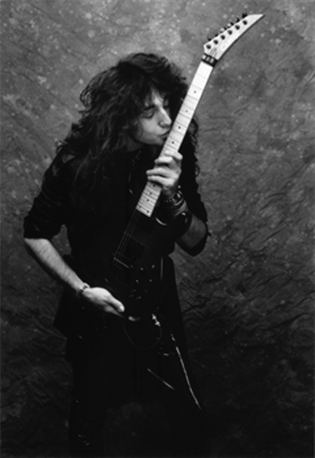 I gave Hunter and Howe my scratch demo solo, but that was just to have a slightly better idea of the melody. I basically told everyone the mood and feel that I wanted. Really the main thing I wanted was to have them do their own interpretations. My old guitar playing is all over the album, so I wanted to take advantage of their unique styles. I am so grateful to them all.
I gave Hunter and Howe my scratch demo solo, but that was just to have a slightly better idea of the melody. I basically told everyone the mood and feel that I wanted. Really the main thing I wanted was to have them do their own interpretations. My old guitar playing is all over the album, so I wanted to take advantage of their unique styles. I am so grateful to them all.
IC: What did you think of the resulting tracks and whose contribution was your favorite?
JB: Funny question. I think they all killed it! My favorite was always the one I had just received. Sometimes the solo inspired me to add another instrument or two. Marty’s solo inspired me to add strings and snare drums.
IC: One of my favorite moments on the album is a new track called ‘Electric Prayer for Peace.’ I like your mix of western modes with various world music influences. What was the writing process like for this track? How do you incorporate these influences into your music?
JB: Thank you very much. That is nice to hear. I wrote the main melody first. I wanted everything to fit over one note, but still be beautiful, melodic and complex over the subtle OM. Then I added the orchestral parts. Then came the lyrics. It took quite a while to find all of the right sounds that I and Dan Alvarez wanted. It wasn’t easy to mix, either, because there are so many layers of tracks. I wrote it with my caregivers following my instructions on a keyboard, a Mac G-5 computer, and Logic Pro software.
As for incorporating world music influences into my own music, that is very tough to answer. I am just inspired by so many types of music. I am a sponge. Finding the notes that I want is the easy part. The hard part is combining different styles together. I have to make little changes and variations in the composition. I really like doing one part, for instance with an Indian style, then another part with a modern classical feel, and then put all of that together in a huge mass of grand music.
IC: Even in your earliest recordings you’ve been fond of sounds that are exotic to western ears, particularly Japanese scales. Can you talk about some of the more unusual scales and modes that are part of your signature sound?

Cacophony’s First Album – Speed Metal Symphony
JB: Marty Friedman turned me on to the Japanese scales. If you are playing in E, the notes are E, F#, G, B, and C – only five notes to the scale. You can also use a major pentatonic scale. If you are in E, the notes are E, F#, G#, B and C#. If you play these notes without a blues type of feel, you get some neat sounds. It isn’t always the scale that makes it sound unique, but how you play something. You can also get weird with 12 tone rows, which is when you don’t repeat one note until you have played all 12 notes in any octave or combination. You can also try stuff like taking one of your simple licks and making every other note an octave lower. These kinds of ideas may help you sound unique.
IC: What kind of music do you listen to these days? Who are some of your favorite artists?
JB: I listen to all kinds of music. And I mean that literally. I love all kinds of world music. I find so much inspiration from different cultures. I am also way into funk, classical, blues, rock, pop, jazz, country…hip hop…
Just yesterday I was shuffling my ipod and I heard things like Jeff Beck, George Clinton, Prince, the Bulgarian Female Choir, Mozart, Debussy, Ennio Morricone, Stevie Ray Vaughan, Miles Davis, John Mayer, Ray Charles, Tupac, Gene Autry, Pink Floyd, Willie Nelson, Paul Simon, Ann Peebles, Van Halen, Dire Straits, Flipsyde, Beyonce, Bob Marley, Megadeth, Stevie Wonder, Nusrat Fateh Ali Khan and the Little Mermaid soundtrack.
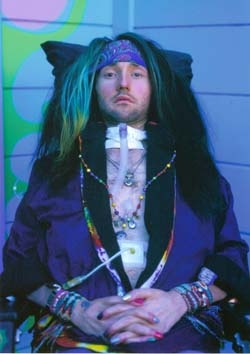
IC: During your late teens you became one of the leading virtuoso guitarists on the scene, and possibly the youngest amongst them. Are there any young players out there today that have intrigued you?
JB: Well, I don’t know how old they are, but I like Jeff Loomis, Mattias Eklundh, Shane Gibson, and Rusty Cooley.
IC: Tell us something about yourself that you haven’t mentioned in previous interviews. It can be anything you want.
JB: I love animals and I don’t understand how anyone could mistreat them. When I was a little kid, I was at the park by myself and I saw a few big kids holding a BB gun in a lizard’s mouth and shooting. I yelled at them to stop, then I ran because I wasn’t very strong. I cried. I have a new black and tan hound dog named Star. She sleeps on the couch. I have three cats named Bear, Ali and Laila. Ali and Laila sleep with me at night.
IC: It is very admirable and inspiring that despite the hardships and challenges that you’ve faced in your life, you have managed to maintain such a positive spirit and a drive to stay creative. What inspires to keep moving forward?
JB: I just dig life and I want to continue doing what I feel I was put here to do. My family and friends are pretty much saints. We have a blast together. I still laugh quite a lot. My guru, Amma, helps and guides me so much. I never feel alone.
IC: Any advice for aspiring musicians?
JB: Be open to all types of music and everything in life. You never know what is going to inspire you to be unique.
—
Click play below to check out the music video for a beautiful composition by Jason called ‘End of the Beginning.’ By the time this piece was written, Jason was no longer able to perform it, so it features Michael Lee Firkins on guitar. In the second video Jason performs Pagannini’s 5th Caprice, which serves as a great display of his fretboard wizardry.
[flashvideo file=https://guitarmessenger.com/wp-content/uploads/2008/12/playlist1.xml height=370 width=400 playlist=bottom playlistsize=54 /]



